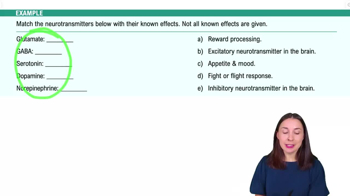Table of contents
- 1. Introduction to Psychology1h 43m
- 2. Psychology Research2h 20m
- 3. Biological Psychology2h 41m
- 4. Sensation and Perception28m
- 5. Consciousness and Sleep32m
- 6. Learning41m
- 7. Memory34m
- 8. Cognition37m
- 9. Emotion and Motivation35m
- 10. Developmental Psychology33m
- 11. Personality48m
- 12. Social Psychology41m
- 13. Stress and Health41m
- 14. Psychological Disorders44m
- 15. Treatment47m
3. Biological Psychology
Communication in the Nervous System
Struggling with Psychology?
Join thousands of students who trust us to help them ace their exams!Watch the first videoMultiple Choice
When neurons fire and transmit messages, they
A
begin slowly, then gradually increase in velocity.
B
begin rapidly, then gradually slow down.
C
do so in an all-or-none fashion.
D
sometimes transmit information partially, depending on signal strength.
 Verified step by step guidance
Verified step by step guidance1
Understand the concept of 'all-or-none' principle in neural firing: Neurons either fire at full strength or not at all, similar to a light switch being either on or off.
Recognize that the 'all-or-none' principle means that once the threshold is reached, the neuron will fire completely, regardless of the strength of the stimulus beyond the threshold.
Consider the process of action potential: When a neuron fires, it generates an action potential that travels down the axon to communicate with other neurons.
Differentiate between the 'all-or-none' principle and other options: Neurons do not gradually increase or decrease in firing speed; they either fire or they don't.
Apply this understanding to the problem: The correct answer is that neurons fire in an all-or-none fashion, meaning they do not transmit information partially or vary in speed based on signal strength.

 1:20m
1:20mWatch next
Master Electrochemical Communication with a bite sized video explanation from Hannah Gordils
Start learningRelated Videos
Related Practice
































